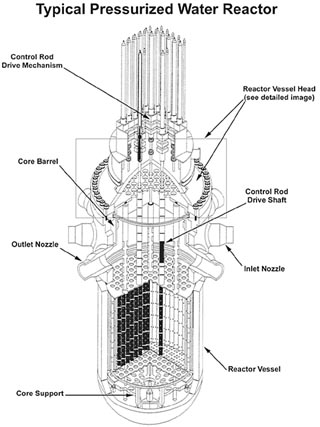Patched Atoms: Feds OK Restarting the Nuke
Despite not really knowing why South Texas Project 1 sprang a leak, federal regulators are satisfied with the $4 million repair job.
By William M. Adler, Fri., Aug. 8, 2003

Among the nation's 103 commercial nuclear reactors, the twin 15-year-old nukes at the South Texas Project -- owned in part by the city of Austin -- are new kids on the pressurized-water block. So it jolted the industry when a routine inspection during an April refueling shutdown uncovered indications of metal fatigue: leaking coolant at the bottom of the massive STP Unit 1 reactor vessel. Though the leak was apparently minor, a "slight seepage," the implications were ominous. With insufficient coolant, the reactor vessel would get very hot, very fast. Lose enough, and Houston, we have a problem. Actually, Houston would have a problem -- of the Chernobyl variety.
The tip-off was a "gummy" white residue of boric acid, in an amount STP officials invariably describe as "about the size of half an aspirin." (Boric acid is used to cool the reactor water by soaking up excess neutrons.) The residue was discovered around the perimeter of two of the 58 instrumentation-tube penetrations at the bottom of the vessel that allow for operators to slide measuring instruments into the nuclear core.
Half an aspirin's worth of stray boric acid on the reactor bottom could prove to be a major headache for the industry. "We've never seen a leak on the bottom [of the vessel]" says Russ Bywater, regional senior reactor analyst for the Nuclear Regulatory Commission. The discovery raises crucial safety questions that reverberate beyond the plant's immediate environs near Bay City, about 90 miles southwest of Houston.
If metal fatigue occurred in a reactor of such a tender age, what might be in store for the nation's many older nuclear plants? Was the South Texas leak an anomaly or a harbinger? And what precautions are in place to prevent future surprises of this sort? If the recent past is any clue, the future is not promising. In March 2002, inspectors at the 25-year-old Davis-Besse plant near Toledo, Ohio, found that boric acid had nearly chomped a football-sized hole in the reactor head. One portion of the 6-inch-thick steel head was so corroded it was reduced to a mere two-tenths of an inch; that's not a lot of wiggle room between containment and Kingdom Come.
The NRC described the Davis-Besse incident as the closest the nation has come to a nuclear accident since the partial meltdown at Three Mile Island in 1979. Davis-Besse remains shut, and 30 other nuclear plants -- nearly a third of the American industry -- have since either replaced their reactor heads or announced plans to do so.
Critics of the NRC -- and they are legion -- say that both Davis-Besse and South Texas 1 illustrate the agency's regulatory shortcomings. Rather than a culture of aggressive oversight, the agency "only recognizes something when it bites them, and this bit them," says Jim Riccio, the nuclear policy analyst for Greenpeace. He finds particular fault with the agency's "risk-based regulatory approach," which, he says, "exposes the public to more risk and the industry to less regulation."
Paul Robbins of Austin, an anti-nuclear activist who a decade ago worked with whistleblowers at STP (then still known as STNP, the South Texas Nuclear Project) alleging faulty construction, says the plant "has been riddled with problems from the time it broke ground." (Because of construction and design defects, and the litigation they spawned, STP went online 10 years behind schedule and about 800% over budget.) Indeed, plant officials attribute the leak to "manufacturing flaws" in the two tubes, says Edward Conaway, spokesman for STP Nuclear Operating Co., which operates the plant for its four owners: Reliant Energy, American Electric Power's subsidiary Central Power and Light, and the cities of San Antonio and Austin.
Repairs have been made, using tubes made of an alloy that was unavailable during construction in the 1970s and 1980s, says an STP fact sheet. But does a new, improved alloy mean a new, improved vessel? "It's a patch, not a fix," says Riccio. "The vessel won't be as strong as it was."
In a document released July 31, the NRC signaled its intent to allow the plant to restart. (Find it online at www.nrc.gov/reactors/operating/ops-experience/bottom-head-penetration-leakage/ bottom-head-penetration-files/07-31-03-se-restart.pdf .) That won't actually occur until at least the end of August, but don't expect to be tipped to the precise date: "That's proprietary information for our owners," says Conaway of STP. When your humble correspondent pointed out to Conaway that as a customer of Austin Energy, which owns 16% of the STP, he considers himself "an owner," Conaway laughed it away. "Nice try," he said.
Nice try? Conaway might consider that the downed Nuke, offline since March, is costing Austin Energy customers between $6 million and $8 million a month, says Ed Clark, spokesman for the city utility. (That doesn't include the $4 million in repair costs that customers of the four utilities will end up sharing.) Austin has to turn to more expensive natural-gas-fired generation, and beyond that to purchases on the spot power market, to make up the lost megawatts normally generated by STP. Guess who ponies up the difference? "That's a cost our customers have to pay," Clark says. The first of three planned increases to Austin Energy's customer fuel charge -- in part to cover STP shutdown shortfalls -- took effect July 1.
Got something to say on the subject? Send a letter to the editor.








